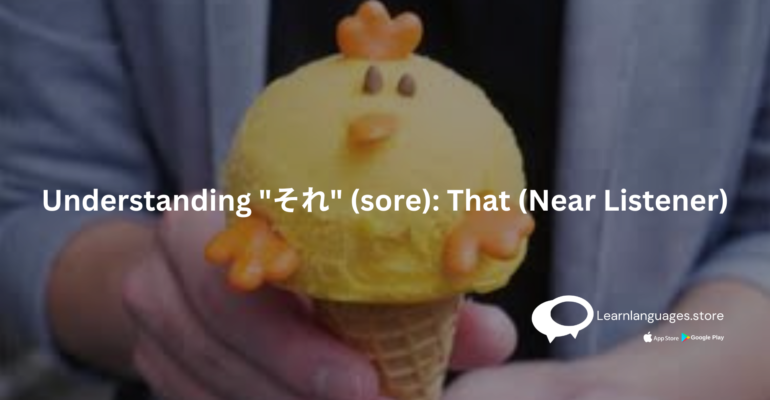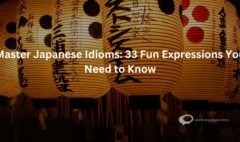Understanding “それ” (sore): That (Near Listener)
Understanding “それ” (sore): That (Near Listener)
Estimated reading time: 4 minutes

Introduction:
Greetings from the fascinating world of Japanese grammar! Today, we will embark on an amusing journey to explore the versatile word “それ” (sore), an essential demonstrative pronoun used to refer to something near the listener. Whether you’re a beginner or an advanced learner, mastering “それ” (sore) will definitely enhance your Japanese conversations. Let’s dive in with plenty of examples, explanations, and some humor to keep things interesting!
What is “それ” (sore)?
“それ” (sore) means “that” in English and is used to refer to something that is close to the listener but not the speaker. It’s one of the three main demonstrative pronouns in Japanese: “これ” (kore), “それ” (sore), and “あれ” (are).
Sentence Structure
In Japanese, demonstrative pronouns like “それ” (sore) are typically used in the following structure:
それ + は + [noun/verb/adjective] + です/だ
- “それ” (sore) – That
- “は” (wa) – Topic marker
- [noun/verb/adjective] – Main content
- です/だ (desu/da) – Copula (polite/casual)
Examples with Humor
Let’s look at some examples to see how “それ” (sore) is used in various contexts. We’ll include English, Hindi translations, and pronunciation guides to make it easier to follow along.
Example 1: Identifying an Object
それはペンです。
- Romaji: Sore wa pen desu.
- Hindi: वह कलम है।
- Pronunciation: वह कलेम है।
English Translation:
- That is a pen.
Usage in a Sentence:
- Your friend is holding a pen, and you point it out by saying, “それはペンです。” (Sore wa pen desu). This identifies the pen near your friend.
Example 2: Asking a Question
それは何ですか?
- Romaji: Sore wa nan desu ka?
- Hindi: वह क्या है?
- Pronunciation: वह क्या है?
English Translation:
- What is that?
Usage in a Sentence:
- Your friend has a strange-looking gadget, and you’re curious. You ask, “それは何ですか?” (Sore wa nan desu ka?). This asks about the object near your friend.
Example 3: Expressing Surprise
それは驚きです!
- Romaji: Sore wa odoroki desu!
- Hindi: वह चौंकाने वाली बात है!
- Pronunciation: वह चौंकाने वाली बात है!
English Translation:
- That is surprising!
Usage in a Sentence:
- Your friend tells you an unbelievable story, and you respond with, “それは驚きです!” (Sore wa odoroki desu!). This expresses your surprise about the story.
Example 4: Complimenting
それは美しいです。
- Romaji: Sore wa utsukushii desu.
- Hindi: वह सुंदर है।
- Pronunciation: वह सुंदर है।
English Translation:
- That is beautiful.
Usage in a Sentence:
- Your friend shows you a beautiful painting, and you say, “それは美しいです。” (Sore wa utsukushii desu). This compliments the painting near your friend.
Example 5: Making a Funny Observation
それはあなたの顔ですか?
- Romaji: Sore wa anata no kao desu ka?
- Hindi: क्या वह आपका चेहरा है?
- Pronunciation: क्या वह आपका चेहरा है?
English Translation:
- Is that your face?
Usage in a Sentence:
- Your friend has a funny face mask on, and you jokingly ask, “それはあなたの顔ですか?” (Sore wa anata no kao desu ka?). This humorously questions the appearance near your friend.
Exceptions and Usage Notes
- それ (sore) is generally not used to refer to people. Instead, use pronouns like “その人” (sono hito) for “that person”.
- In casual conversations, “それ” (sore) can sometimes be replaced with just “そ” (so) in spoken Japanese for brevity.
- Remember that “それ” (sore) is used for objects and concepts near the listener. For items near the speaker, use “これ” (kore), and for items far from both, use “あれ” (are).
Conclusion
Understanding “それ” (sore) is a crucial step in mastering Japanese demonstrative pronouns. It allows you to clearly refer to objects near the listener and helps make your conversations more precise. With practice and a bit of humor, you’ll find using “それ” (sore) becomes second nature.
So, the next time your friend shows you something interesting, remember to use “それ” (sore) and impress them with your Japanese skills!
-
Product on sale
 Japanese N4
Japanese N4₹18,300.00
₹24,300.00 -
Product on sale
 Japanese N5
Japanese N5₹16,300.00
₹18,300.00
Learn Languages Store
Vashi,
Email: services@learnlanguages.store










